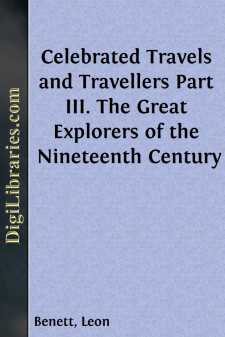Non-Classifiable
- Non-Classifiable 1768
Non-Classifiable Books
Sort by:
INTRODUCTION. This book is the outcome of many years of study. With the exception of a few quotations, none of the material has ever before appeared in any book. The writer has been indebted for years past to many of the physicians mentioned in the following pages for copies of pamphlets and magazines, and for newspaper articles, bearing upon the medical study of alcohol. Indeed, had it not been for...
more...
Until the middle of this (the nineteenth) century the favorite theory with those who attempted to explain the phenomena of History was the Great-Man-Theory. This theory was that once in a while through infinite mercy a great man was sent to the earth who yanked humanity up a notch or two higher, and then we went along in a humdrum way on that level, or even sank back till another great man was...
more...
The moment in which fear had instigated my flight, did not seem more terrible than that wherein I put my design in execution appeared delightful. To leave my relations, my resources, while yet a child, in the midst of my apprenticeship, before I had learned enough of my business to obtain a subsistence; to run on inevitable misery and danger: to expose myself in that age of weakness and innocence to...
more...
CHAPTER I. INTRODUCTORY. Assaying has for its object the determination of the quantities of those constituents of a material which add to or detract from its value in the arts and manufactures. The methods of assaying are mainly those of analytical chemistry, and are limited by various practical considerations to the determination of the constituents of a small parcel, which is frequently only a few...
more...
PART I.—INTRODUCTORY AND HISTORICAL. Section 1.—Origin and Scope of Inquiry. A perusal of departmental files reveals that many persons and bodies have during recent times urged upon the Government the desirability of setting up a Committee or Commission of Inquiry to go into this subject. The appointment of the present Committee, however, arose out of a suggestion forwarded to the Chairman of the...
more...
by:
Anonymous
PREFACE. Peter Piper, without Pretension to Precocity or Profoundness, Puts Pen to Paper to Produce these Puzzling Pages, Purposely to Please the Palates of Pretty Prattling Playfellows, Proudly Presuming that with Proper Penetration it will Probably, and Perhaps Positively, Prove a Peculiarly Pleasant and Profitable Path to Proper, Plain and Precise Pronunciation. He Prays Parents to Purchase this...
more...
ESSAY ON TOBACCO. In the great kingdom of living nature, man is the only animal that seeks to poison or destroy his own instincts, to turn topsy-turvy the laws of his being, and to make himself as unlike, as possible, that which he was obviously designed to be. No satisfactory solution of this extraordinary propensity has been given, short of a reference to that— "first disobedience and the fruit...
more...
by:
Walter Hubbell
CHAPTER I. THE HOME OF ESTHER COX. Amherst, Nova Scotia, is a beautiful little village on the famous Bay of Fundy; has a population of about three thousand souls, and contains four churches, an academy, a music hall, a large iron foundry, a large shoe factory, and more stores of various kinds than any village of its size in the Province. The private residences of the more wealthy inhabitants are very...
more...
by:
P. L. Simmonds
INTRODUCTORY. The want of a practical work treating of the cultivation and manufacture of the chief Agricultural Productions of the Tropics and Foreign Countries, has long been felt, for not even separate essays are to be met with on very many of the important subjects treated of in this volume. The requirements of several friends proceeding to settle in the Colonies, and wishing to devote themselves...
more...
by:
Leon Benett
CHAPTER I.THE DAWN OF A CENTURY OF DISCOVERY.Slackness of discovery during the struggles of the Republic and Empire—Seetzen's voyages in Syria and Palestine—Hauran and the circumnavigation of the Dead Sea—Decapolis—Journey in Arabia—Burckhardt in Syria—Expeditions in Nubia upon the two branches of the Nile—Pilgrimage to Mecca and Medina—The English in India—Webb at the Source of...
more...











